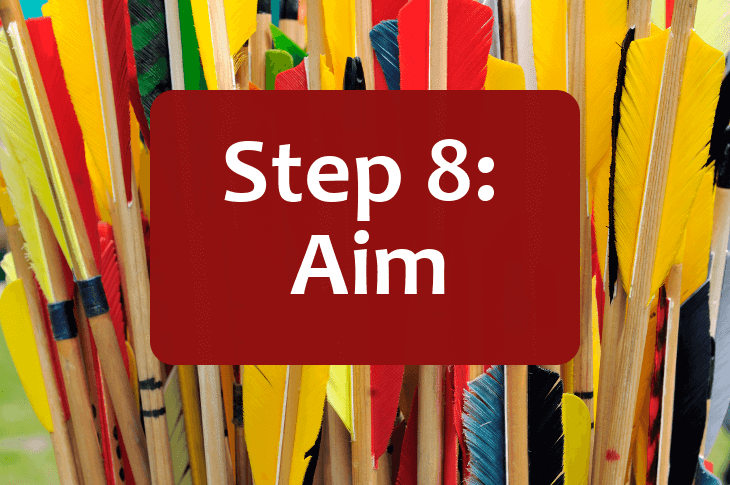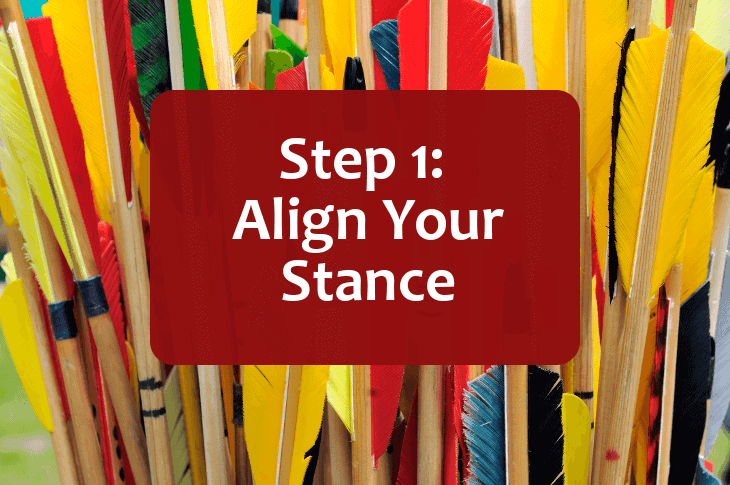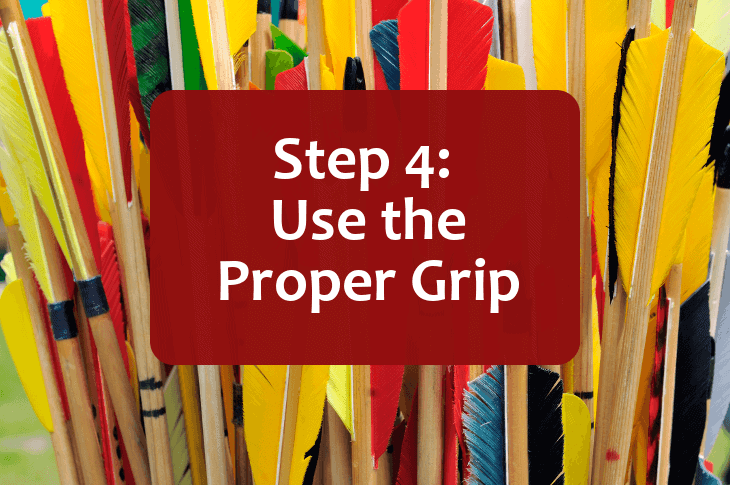Welcome! This is Step #8 in our “How to Shoot a Bow and Arrow” lesson. This is it—the big step! AIM! (If you want to see a list of all the steps, click right over here).
When you’re aiming, you’ve got two main options: aim using a bow sight, or do some instinctive shooting (that is, shooting without a sight). Sights are more popular than ever, but there are still a lot of people who love the challenge of instinctive shooting, so we’ll go over both.

How to Use a Bow Sight
Aiming with a Sight is Pretty Natural. At full draw, find your target, use your dominant eye to focus on the target, and orient the bow so that when you look through the bow sight, the pin meets the target in your line of sight. That’s it! Do that and you’re good to go.
Chase the Arrows. Very often, your sight won’t be accurate, and you’ll find that you’re grouping arrows above or below or to the left or right of the bull’s eye (or whatever 3D target you’re shooting at). You’ll need to need to re-adjust it so that your sight will align with the target. Here’s how you do that: you “chase your arrows.”
If your arrows are landing to the right of the target, move your scope a little to the right, and after you shoot a few more, you’ll find that you’re no longer shooting them so far right. If your arrows are landing above the target, raise your scope a little, and you’ll find that the next arrows you shoot will land a little bit lower. Remembering that phrase—“chase your arrows” is a good way to remember how to fine-tune your scope, especially if you’re at the beginning of your archery journey.
Some Other Details to Keep in Mind. Two things:
- Bow sights go all the way from rinky-dinky to very, very sophisticated. If you’re a beginner, don’t worry about getting the fanciest product on the market. A very simple bow sight is 100% fine for target practice at the range.
- Some sights actually have multiple pins, for shooting targets at different distances. For these, you’ll aim using the top pin for closer targets, the middle pin for medium-range targets, and the bottom pin for far targets. Recurve archers don’t need to worry about this, as they usually shoot at a static target, but if you’re using a compound bow and want to get into hunting, it’s good to get used to using a multiple-pin bow sight.
Ditch the Sight and Go Instinctive
Instinctive archers use experience—and their own subconscious—to connect arrows to their targets. For some, it’s a mystical art, while others use a scientific approach. To be honest, I don’t know too much about it, so I will defer to the experts: Grizzly Jim has a great YouTube channel dedicated to instinctive archery, as does Guy Fitzgerald and Jeff Kavanagh. These fellas are all characters, and they loooooove archery. Go to YouTube and search for them. I could watch their videos for days—fascinating guys.
Aiming on a Recurve Bow vs. Aiming on a Compound Bow
When you’re learning how to aim a bow and arrow, you’ll have a very different experience on a recurve vs. a compound.
For experienced archers (and that’s important—“for experienced archers”), the ideal aiming process between a recurve bow and a compound bow is slightly different: recurve archers tend to release their arrows quickly, whereas compound archers tend to come to a full draw, and then take a few seconds to aim.
Let’s take a look at how this plays out in a competition. Here are a few Olympic recurve archers who come to full draw and use very little time to aim (jump to 2:30 to see exactly what I’m talking about):
UPDATE!! I just found out that that video won’t work! What a bummer. You can jump to YouTube and view it here.
Let’s compare that to the competitive compound archers here, who come to full draw, and then take a few seconds to aim before releasing:
The difference in aiming technique is pretty significant. So why the difference between aiming strategies?
- Compound bows have a very specific bow length. After a certain point, it’s very difficult to draw a compound bow further back, whereas a recurve bow is very easy to overdraw (and, as we learned in the “Find Your Anchor” step, and overdrawn bow will likely lead to inaccurate shots). Because recurve shooters need to be careful about overdrawing, they use a tool—the clicker, which I’ll discuss below—to tell them exactly when they’re at the correct draw. They shoot as soon as the clicker goes off because waiting could result in the draw length growing or shrinking a little bit the longer they hold it.
- Compound bows are traditionally used for hunting, and hunters may need to aim for longer periods of time to make a humane kill. When a hunter has his target in sight—be it a deer, an elk, a boar, or whatever—he wants to be certain to kill it quickly and humanely. That means setting up the perfect shot on a target that may be moving a little bit—so patiently aiming and waiting for the perfect release is important. Olympic archers and competitive archers, on the other hand, want to perfect a strict shooting sequence, with no variation in timing.
Above, I mention a tool called the clicker. The clicker is an instrument that lets the archer maintain a consistent draw length, on every shot. That means that as soon as they reach their exactly-measured draw length, they release the arrow—so they’re aiming during their draw with the expectation to let go of the arrow at the correct draw length. Here’s a great (quick) video about what it is and how it’s used.
So how does this apply to you, as a new archer?
- If you’re using a compound bow, you’re good to go—you won’t need to use a clicker because you’re on a compound bow, so you can fully draw the bow, aim until you’re confident you’ll connect with your target, and then release.
- If you’re using a recurve bow and you’re new to archery, you also shouldn’t yet worry about the clicker. It’s an advanced tool, and you’ll need to have your form down pat, and have gear that fits you perfectly (because to use a clicker, you need to have arrows that are perfectly sized for you and your bow). What you can and should do is develop strength and experience, figure out the bow measurements that fit you perfect, and most importantly, find your anchor point (which we talked about in Step #7). Once you’ve done all that and have a deeper knowledge of your shot, look into getting a clicker.
This is one of those things that I mention not because it’s something you need to know as a beginner, but because it’s something you should keep in mind if you become more committed to target archery with a recurve bow.
A Tip for Compound Bow Users
During the aiming process, I’ve found that I’ve had greater success not when I purposefully move my arm to align with the bullseye, but instead, when I pay attention to the sight and target, and release when the sight is over the target. That may sound a little confusing, so let me explain it another way:
My old method was to focus on the target and aim, and when I felt that I had matched the sight to the target, I would release the arrow. But eventually I realized that the method wasn’t working, because it’s impossible to hold your arm perfectly still (for me, at least!). So instead, I aim for the target, and when I sense that my moving towards the bullseye or whatever I want to hit, that’s when I release the arrow.
Explained even a different way: I used to aim, freeze, and release; now I aim, wait for the sight to meet the target, and release.
I’m still not quite satisfied with that explanation, but I hope it works for you… if you’re confused or have questions, please leave a comment below!
By the way—I’m not saying that this is a strategy everyone should use (and if you’re an archery coach and you’re reading this, I’d love for you to leave a comment below!); I’m saying that it’s a technique I’ve been experimenting with and had success with; if you find that it works for you, that’s fantastic.
Relaaaaaaaaaaaaaaaaaaaaax
So you’ve drawn the bow and you’ve got specific muscles tensed and taught. Everywhere else—relax! The looser you are, the better.
I am not—not, not, not saying—I am not saying—get so relaxed the bow slips or your bow arm falls or anything like that.
I’m saying to relax the parts of your body that are not intimately involved in your shot—your face muscles, your neck, your quads, even the little muscles in your feet and between your toes. The more calm and relaxed you are, the more accurate you’ll be. That’s true if you’re target shooting OR hunting—and, come to think of it, it’s a good approach for every other part of your life, too.
We’re Going to Get Kind of Zen for a Moment, So Just Bear with Me
Aiming is my favorite part of the process (or, one of them, anyway). Once I’ve gone through all the other steps—checked my posture, my alignment, etc. etc. and then drawn and set my anchor, I try to let my thoughts… totally… go. If a thought pops into my head—and it almost always does—I let that thought go, too. I try to mentally relax and be totally present in my quest to connect with my target.
There is a lot written about archery and meditation, and archery and meditative states. It’s fascinating stuff, and it’s something that I try to incorporate into my own archery practice. I try to think only of the target, and let any extraneous thoughts—about work, about bills, even about things I love—float away from me.
Nothing exists in that moment except for me and my target. (By the way, if you’re an experienced archer and you’re reading this and thinking, “I actually get meditative during a different part of process”—PLEASE leave a comment below and tell me about it. I’d really love to hear your insights).
Next Up: RELEASE
That’s right—we’re finally there: the arrow release.




